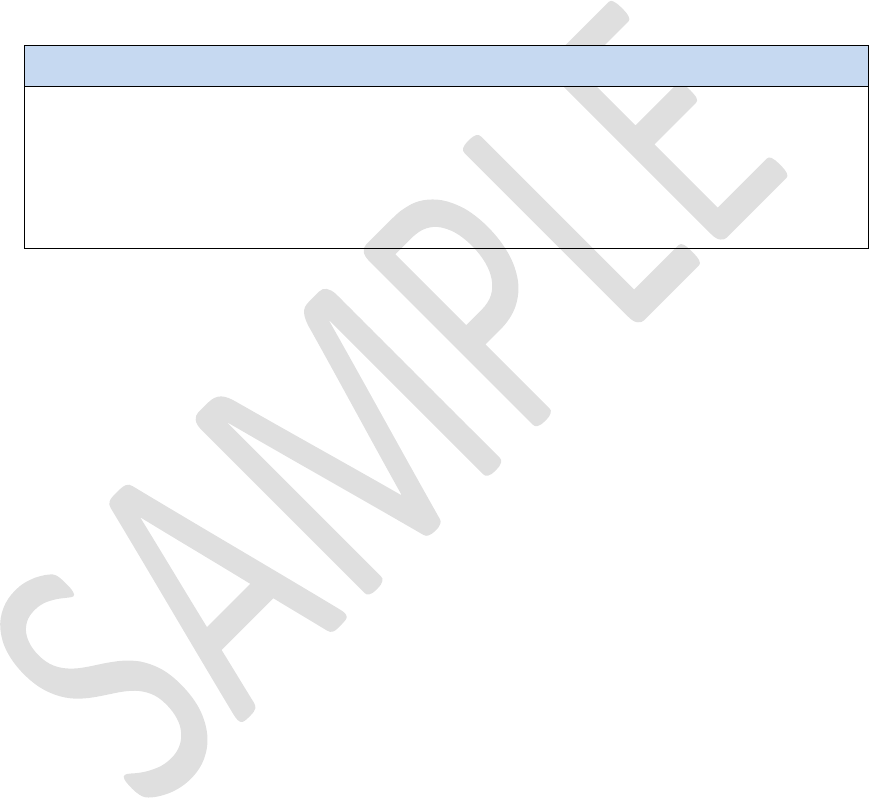
SafeConduct™ Policy & Procedure Template
©Insurance Board, June 2017 edition
This template is provided as a service by the Insurance Board, a non-profit insurance and risk
management ministry, as a service to churches and camps of the denominations it serves: The Christian
Church (Disciples of Christ), Presbyterian Church USA, Alliance of Baptists, and United Church of Christ.
The materials provided are based, in part, on guidance provided by Praesidium, Inc., our business partner
and consultant in matters of abuse prevention.
The volume of material presented here may be found intimidating and beyond the ability or willingness of
a church or camp to execute. It is the responsibility of church leaders to determine the necessary
components of policy. (A significant part of the material below is guidance and sample forms.)
While this template is focused primarily on child abuse prevention, opportunities will be identified to
address other issues that relate to SafeConduct™, to include sexual harassment, professional boundaries,
sexual orientation, bullying and exploitation of vulnerable adults. Users will find that principles applying
to abuse prevention can apply to and are easily adaptable to the other vulnerable groups although different
specific techniques may apply.
Depending upon the nature of [CHURCH NAME], whether a church, camp, or other non-profit, you may
customize terms to suit your culture. For example, you may wish to insert a variety of scriptural references.
This particular policy statement is very broad and goes beyond child sexual abuse to include elements of
employment practices and other at-risk groups. For example, a church may routinely provide an overflow
homeless shelter where families and persons with mental illnesses are present.
While many churches use terms such as “safe church”, “safe sanctuary” or similar terms for their policies,
we have adopted throughout the policy template the term SafeConduct™. Our strategy is to focus less on
a fortress place and more on the importance of personal behavior and personal responsibility in abuse
prevention. While SafeConduct™ is a trademarked term, any church or non-profit camp within the
denominations we serve is free to use it. Some have already chosen to incorporate it. We are pleased that
you do.
Congregational Approval – Creating a policy for the first time will not always be easy and may take more
time than expected. Some will resist the vetting and oversight that is implicit in an effective program. It
will be important that you engage your congregation in the process and arrive at consensus. When it comes
time to vote on adoption, the details of the policy and procedure must not be a surprise. Be sure to
understand what your Constitution or By-Laws may require to obtain approval.
Policy Language – Throughout this template, procedures are expressed as imperatives (shall, will). Vague
terms such as “should” or “may” are specifically avoided. Responsibility for specific actions are assigned
to “individuals” (usually by title), not to groups or committees. Each individual must understand his/her
specific responsibility.

CAUTION
Editing Required – This template cannot be adopted “as is.” It requires tailoring to your church/camp
management and program structure and to your ability to actually fulfill its requirements. NO
POLICY/PROCEDURE CAN BE ADOPTED WHICH YOU CANNOT LIVE AND FULFILL
COMPLETELY.
Copyright Notice: This document is intended for the exclusive use of religiously affiliated organizations which are
eligible to be served by Insurance Board programs. Reproduction of this document for commercial purposes is
prohibited

1
Table of Contents
I. Statement of Policy .............................................................................................................. 2
II. General Definitions .............................................................................................................. 3
III. Code of Conduct with Youth and Vulnerable Adults ............................................................. 4
IV. Policies for Working with Youth ............................................................................................ 7
A. Physical Contact ............................................................................................................. 7
B. Verbal Interactions .......................................................................................................... 8
C. One-on-One Interactions ................................................................................................. 9
D. Off-site Contact ............................................................................................................. 10
E. Electronic Communication ............................................................................................. 11
F. Gift Giving ..................................................................................................................... 12
V. Screening and Selection ................................................................................................... 13
VI. Training............................................................................................................................. 16
VII. Monitoring and Supervision................................................................................................ 18
A. Facility Monitoring ......................................................................................................... 18
B. General Supervision ...................................................................................................... 18
C. Monitoring Youth in Facilities ......................................................................................... 18
D. Monitoring High Risk Activities ...................................................................................... 20
E. Supervisors and Administrators Monitoring On-Site and Off-Site Programs .................. 25
VIII. Responding ....................................................................................................................... 26
A. Responding to Suspicious or Inappropriate Behaviors or Policy Violations .................... 26
B. Responding to Suspected Abuse by an Adult ................................................................ 28
C. Responding to Youth-to-Youth Sexual Abuse and Sexualized Behaviors ...................... 29
D. Responding to Victims ................................................................................................... 31
E. Notification of Parents ................................................................................................... 31
F. Responding to Media .................................................................................................... 32
IX. Congregational Awareness ................................................................................................ 33
X. Registered Sex Offender Policy ......................................................................................... 34
XI. Acknowledgement of SafeConduct Policy and Procedure...................................................37
XII. Appendices...........................................................................................................................38
A. Sample Application...........................................................................................................39
B. Sample Reference Check Questions...............................................................................44
C. Sample Field Trip Preparation Checklist..........................................................................49
D. Sample Volunteer Driver Qualification Form & Agreement..............................................51
E. Sample Limited Access Agreement..................................................................................52

2
Statement of Policy
As a community of Christian faith, [CHURCH NAME] is committed to creating and maintaining
programs, facilities and a community in which members, friends, Clergy, employees, and
volunteers can worship, learn and work together in an atmosphere free from all forms of
discrimination, harassment, exploitation or intimidation. The congregation of [CHURCH NAME]
supports principles of SafeConduct, which include individual responsibility to fulfill the highest
standards of personal conduct toward others and to lead and guide the congregation in fulfillment
of the standards set by our Christian faith. [CHURCH NAME] strongly opposes and prohibits
“sexual exploitation”, “sexual harassment” or any form of exploitation or abuse of others regardless
of age, sex, sexual orientation, sexual identification or mental capacity. It is the intention of our
congregation to affirmatively nurture good behavior, and to prevent and correct behavior that is
contrary to this policy and, as necessary, discipline those persons who violate this policy.
Every member of the Congregation, whether “authorized clergy”, leader, lay staff, volunteer or
parent, has a role to lead those who look to them individually for guidance, to monitor their behavior
and redirect them as they cross boundaries of SafeConduct. Our congregation shall nurture good
conduct as demonstrated by personal behaviors that are consistent with our Christian values. As we
might conduct an orchestra, we shall guide and lead in ministry.

3
General Definitions
1. Physical abuse is injury that is intentionally inflicted upon a youth.
2. Sexual abuse is any contact of a sexual nature that occurs between a youth and an adult or
between two youths. This includes any activity which is meant to arouse or gratify the sexual
desires of the adult or the other youth.
3. Emotional abuse is mental or emotional injury to a youth that results in an observable and
material impairment in the youth’s growth, development, or psychological functioning.
4. Neglect is the failure to provide for a youth’s basic needs or the failure to protect a youth from
harm.
5. A Minor is anyone under the age of 18 (also referred to as youth throughout policy).
6. A Vulnerable Adult is anyone aged 18 or over, who is or may be in need of community care
services by reason of mental or other disability, age, or illness, and who is or may be unable to
take care of him or herself, or unable to protect him or herself against significant harm or
exploitation.
7. Mandatory Reporters are those persons required by [YOUR STATE] law to report suspected
abuse to police or child welfare agencies.
8. Authorized Clergy includes any person who is admitted to ministry by [YOUR
DENOMINATION], who serves the congregation in any capacity whether called as pastor or
serving in a retired, emeritus, administrative, or volunteer capacity.

4
Code of Conduct with Youth and Vulnerable Adults
The following Code of Conduct is intended to assist Clergy, employees, and volunteers in making decisions
about interactions with youth and vulnerable adults. For clarification of any guideline, or to inquire about
behaviors not addressed here, contact your supervisor.
[CHURCH NAME] provides our youth and vulnerable adults with the highest quality services available.
We are committed to creating an environment for youth and vulnerable adults that is safe, nurturing,
empowering, and that promotes growth and success.
No form of abuse will be tolerated, and confirmed abuse will result in immediate dismissal from [CHURCH
NAME]. All reports of suspicious or inappropriate behavior with youth and vulnerable adults or allegation
of abuse will be taken seriously. [CHURCH NAME] will fully cooperate with authorities if allegations of
abuse are made that require investigation.
The Conduct with Youth and Vulnerable Adult outlines specific expectations of the Clergy, employees,
and volunteers as we strive to accomplish our mission together.
Youth and vulnerable adults will be treated with respect at all times.
Youth and vulnerable adults will be treated fairly regardless of race, sex, age, or religion.
Clergy, employees, and volunteers will adhere to uniform standards of displaying affection as
outlined by [CHURCH NAME].
Clergy, employees, and volunteers will avoid affection with youth and vulnerable adults that cannot
be observed by others.
Clergy, employees, and volunteers will adhere to uniform standards of appropriate and
inappropriate verbal interactions as outlined by [CHURCH NAME].
Clergy, employees, and volunteers will not stare at or comment on youth and vulnerable adults’
bodies.
Clergy, employees, and volunteers will not date or become romantically involved with youth and
vulnerable adults.
Clergy, employees, and volunteers will not use or be under the influence of alcohol or illegal drugs
in the presence of youth and vulnerable adults.
Clergy, employees, and volunteers will not have sexually oriented materials, including printed or
online pornography, on [CHURCH NAME]’s property.
Clergy, employees, and volunteers will not have secrets with youth and vulnerable adults and will
only give gifts with prior permission.
Clergy, employees, and volunteers will comply with [CHURCH NAME]’s policies regarding
interactions with youth and vulnerable adults outside of our programs.

5
Clergy, employees, and volunteers will not engage in inappropriate electronic communication with
youth and vulnerable adults.
Clergy, employees, and volunteers are prohibited from working one-on-one with youth and
vulnerable adults in a private setting. Clergy, employees, and volunteers will use common areas
when working with individual youth and vulnerable adults.
Clergy, employees, and volunteers will not abuse youth and vulnerable adults in anyway including
(but not limited to) the following:
Physical abuse: hitting, spanking, shaking, slapping, unnecessary restraints;
Verbal abuse: degrading, threatening, cursing;
Sexual abuse: inappropriate touching, exposing oneself, sexually oriented conversations;
Mental abuse: shaming, humiliation, cruelty; and
Neglect: withholding food, water, shelter
[CHURCH NAME] will not tolerate the mistreatment or abuse of one youth or vulnerable adult by
another youth or vulnerable adult. In addition, [CHURCH NAME] will not tolerate any behavior
that is classified under the definition of bullying, and to the extent that such actions are disruptive,
we will take steps needed to eliminate such behavior.
Bullying is aggressive behavior that is intentional, is repeated over time, and involves an imbalance
of power or strength. Bullying can take on various forms, including:
a. Physical bullying – when one person engages in physical force against another person, such
as by hitting, punching, pushing, kicking, pinching, or restraining another.
b. Verbal bullying – when someone uses their words to hurt another, such as by belittling or
calling another hurtful names.
c. Nonverbal or relational bullying – when one person manipulates a relationship or desired
relationship to harm another person. This includes social exclusion, friendship
manipulation, or gossip. This type of bullying also includes intimidating another person by
using gestures.
d. Cyberbullying – the intentional and overt act of aggression toward another person by way
of any technological tool, such as email, instant messages, text messages, digital pictures
or images, or website postings (including blogs). Cyberbullying can involve:
• Sending mean, vulgar, or threatening messages or images.
• Posting sensitive, private information about another person.
• Pretending to be someone else in order to make that person look bad.
• Intentionally excluding someone from an online group.
• Hazing – an activity expected of someone joining or participating in a group that
humiliates, degrades, abuses, or endangers that person regardless of that person’s
willingness to participate.

6
• Sexualized bullying – when bullying involves behaviors that are sexual in nature.
Examples of sexualized bullying behaviors include sexting, bullying that involves
exposures of private body parts, and verbal bullying involving sexualized language
or innuendos.
Anyone who sees an act of bullying, and who then encourages it, is engaging in bullying. This
policy applies to all youth and vulnerable adults, Clergy, employees, and volunteers.
All Clergy, employees, and volunteers must follow state specific mandatory reporting
requirements. They should be trained to be aware of and understand their legal and ethical
obligation to recognize and report suspicions of mistreatment and abuse. They will:
a. Be familiar with the symptoms of child abuse and neglect, including physical, sexual,
verbal, and emotional abuse.
b. Know and follow organization policies and procedures that protect youth and vulnerable
adults against abuse.
c. Report suspected child abuse or neglect to the appropriate authorities as required by state
mandated reporter laws.
d. Follow up to ensure that appropriate action has been taken.
Clergy, employees, and volunteers will report concerns or complaints about other employees,
volunteers, adults, or youth to [CHURCH NAME]’s supervisor or Praesidium’s Anonymous
Helpline at 855-347-0751.
[CHURCH NAME] cooperates fully with the authorities to investigate all cases of alleged abuse.
Any Clergy, employee, or volunteer shall cooperate to the fullest extent possible in any external
investigation by outside authorities or internal investigation conducted by the organization or
persons given investigative authority by the organization. Failure to cooperate fully may be grounds
for termination.
Clergy, employees, and volunteers may not have engaged in or been accused or convicted of youth
and vulnerable adult abuse, indecency with a youth and vulnerable adult, or injury to a youth and
vulnerable adult.

7
Policies for Working with Youth
Policies define the bandwidth of acceptable behavior in an organization. Because offenders often violate
policies to gain access to youths, when staff know and understand policies, they can identify, interrupt, and
report policy violations. Simply interrupting a policy violation can prevent a false allegation of abuse or put
an offender on notice that no one works in private, the rules apply to everyone, and violations will be
detected.
A. Physical Contact
[CHURCH NAME]’s physical contact policy promotes a positive, nurturing environment while
protecting youths, Clergy, employees, and volunteers. [CHURCH NAME] encourages appropriate
physical contact with youths and prohibits inappropriate displays of physical contact. Any inappropriate
physical contact by Clergy, employees, and volunteers towards youths in the organization’s programs
will result in disciplinary action, up to and including termination of employment.
[CHURCH NAME]’s policies for appropriate and inappropriate physical interactions are:
Appropriate Physical Interactions
Inappropriate Physical Interactions
• Side hugs
• Shoulder-to-shoulder or “temple” hugs
• Pats on the shoulder or back
• Handshakes
• High-fives and hand slapping
• Verbal praise
• Pats on the head when culturally
appropriate
• Touching hands, shoulders, and arms
• Arms around shoulders
• Holding hands (with young children in
escorting situations)
• Full-frontal hugs
• Kisses
• Showing affection in isolated area
• Lap sitting
• Wrestling
• Piggyback rides
• Tickling
• Allowing a youth to cling to an
employee’s or volunteer’s leg
• Any type of massage given by or to a
youth
• Any form of affection that is unwanted by
the youth or the staff or volunteer
• Compliments relating to physique or
body development
• Touching bottom, chest, or genital areas

8
B. Verbal Interactions
Clergy, employees, and volunteers are prohibited from speaking to youths in a way that is, or could be
construed by any observer, as harsh, coercive, threatening, intimidating, shaming, derogatory,
demeaning, or humiliating. Clergy, employees, and volunteers must not initiate sexually oriented
conversations with youths. Clergy, employees, and volunteers are not permitted to discuss their own
sexual activities with youths.
[CHURCH NAME]’s policies for appropriate and inappropriate verbal interactions are:
Appropriate Verbal Interactions
Inappropriate Verbal Interactions
• Positive reinforcement
• Appropriate jokes
• Encouragement
• Praise
• Name-calling
• Discussing sexual encounters or in any
way involving youths in the personal
problems or issues of Clergy, employees,
and volunteers
• Secrets
• Cursing
• Off-color or sexual jokes
• Shaming
• Belittling
• Derogatory remarks
• Harsh language that may frighten,
threaten or humiliate youths
• Derogatory remarks about the youth or
his/her family

9
C. One-on-One Interactions
Most abuse occurs when an adult is alone with a youth. [CHURCH NAME] aims to eliminate or reduce
these situations and prohibits private one-on-one interactions unless approved in advance by the
organization administration.
In those situations where one-on-one interactions are approved, Clergy, employees, and volunteers
should observe the following additional guidelines to manage the risk of abuse or false allegations of
abuse:
Additional Guidelines for One-on-One Interactions
• When meeting one-on-one with a youth, always do so in a public place where you are in
full view of others.
• Avoid physical affection that can be misinterpreted. Limit affection to pats on the shoulder,
high-fives, and handshakes.
• If meeting in a room or office, leave the door open or move to an area that can be easily
observed by others passing by.
• Inform other Clergy, employees, and volunteers that you are alone with a youth and ask
them to randomly drop in.
• Document and immediately report any unusual incidents, including disclosures of abuse or
maltreatment, behavior problems and how they were handled, injuries, or any interactions
that might be misinterpreted.
Tutoring/ Private Coaching:
One-on-one situations, such as tutoring and private coaching sessions, introduce additional risks
for false allegations. Clergy, employees, and volunteers should be aware of our policies regarding
tutoring and private coaching:
a. Clergy, employees, and volunteers must have supervisor approval for any tutoring or
private coaching sessions.
b. Tutoring and coaching sessions with [CHURCH NAME]’s youths may not occur outside
of the organization.
c. Supervisors must keep a schedule of private tutoring and coaching sessions, which should
include times, youths involved, and location of sessions.

10
D. Off-site Contact
Many cases of organizational abuse occur off-site and outside of regularly scheduled activities. This
contact outside of regularly scheduled activities may put staff, volunteers, and [CHURCH NAME] at
increased risk.
1. (Preferred) Option One:
[CHURCH NAME] prohibits interactions outside of regularly scheduled program activities unless
approved by the organization’s Administration.
2. Option Two:
[CHURCH NAME] strongly recommends that staff do not have outside contact with youths from
the organization. However, if off-site contacts are unavoidable (such as during mentoring
programs), [CHURCH NAME] has determined that the following forms of outside contact are
appropriate and inappropriate:
Appropriate Outside Contact
Inappropriate Outside Contact
• Taking groups of youths on an outing
• Attending sporting activities with groups
of youths
• Attending functions at a youth’s home,
with parents present
• Taking one youth on an outing without the
parents’ written permission
• Visiting one youth in the youth’s home,
without a parent present
• Entertaining one youth in the home of staff
or volunteers
• A lone youth spending the night with staff
or volunteers
In addition, when outside contact is unavoidable, ensure that the following steps are followed:
1. Supervisors should identify for Clergy, employees, and volunteers what types of outside
contact are appropriate and inappropriate.
2. Ensure that staff or volunteers have the parents’ permission to engage in outside contact with
the youth. Consider requiring the parents to sign a release-of-liability statement.

11
E. Electronic Communication
Any private electronic communication between staff and youths, including the use of social networking
websites like - Facebook, Instagram, Snapchat, instant messaging, texting, etc. - is prohibited. All
communication between staff and youths must be transparent.
The following are examples of appropriate and inappropriate electronic communication:
Appropriate Electronic Communication
Inappropriate Electronic Communication
• Sending and replying to emails and text
messages from youths ONLY when
copying in a supervisor or the youth’s
parent
• Communicating through “organization
group pages” on Facebook or other
approved public forums
• “Private” profiles for Clergy, employees,
and volunteers which youths cannot
access
• Harsh, coercive, threatening, intimidating,
shaming, derogatory, demeaning or
humiliating comments
• Sexually oriented conversations
• Private messages between Clergy,
employees, and volunteers with youths
• Posting pictures of organization
participants on social media sites
• Posting inappropriate comments on
pictures
• “Friending” participants on social
networking sites
In addition, provide this information to your participant’s parents so that they know what is appropriate and
inappropriate from your staff.
Cell Phone Use:
While assigned to work with youths, staff are not permitted to use electronic communications
device except during approved breaks and emergency situations. Internet use, text messaging
and/or emailing pictures while assigned to work with youths is strictly prohibited regardless of the
type of device used and whether for business or personal reasons. Employees need to ensure that
friends and family members are aware of this policy.
Use of personal electronic communication devices to contact (via voice, text, or pictures/video)
organization members and/or program participants for personal and/ or inappropriate reasons shall
be grounds for discipline up to and including termination of employment.
There are occasions in which staff will need to use personal or organization issued electronic
communication devices. In these cases, staff will have explicit direction from supervisors
governing use. Situations which may require use of organization issued or personal electronic
communication devices include:
a. Field Trips;
b. Off-site Programs; and
c. Emergencies.

12
F. Gift Giving
Molesters routinely groom youths by giving gifts, thereby endearing themselves to the youth. They
might instruct the youth to keep the gifts a secret, which then starts teaching the youth to keep secrets
from parents. For this reason, Clergy, employees, and volunteers should only give gifts to groups of
youths, and only under the following circumstances:
1. Administration must be made aware of and approve the gift.
2. Parents must be notified.

13
Screening and Selection
The process of screening and selecting employees and volunteers is an essential element of management
due diligence. There are several elements required which serve a number of purposes. Criminal
background checking by itself is inadequate simply because very few predators, or people who would
become predators, have been through the penal system. A would-be predator requires three things: Access,
Privacy & Control.
Standing of “Authorized Clergy”: Each denomination served by the Insurance Board has a process of
granting professional standing to clergy. Employment of clergy who do not fulfill denominational
requirements may have an impact on insurance programs. Consult your insurance agent if there are
concerns.
The following screening and selection procedures are strongly recommended for all Clergy, employees,
and volunteers.
Note: Each board member, employee or volunteer now serving and regardless of length of service must be
willing to set an example for all others who follow in their ministry. Therefore, at the time this policy is
first adopted, all incumbent board members, employees and all incumbent volunteers who work with
children shall execute the following procedures.
A. Standardized Application
All applicants should be expected to complete an application prior to working at [CHURCH NAME].
The application should be reviewed by Employment Committee for completeness, high risks and fit
with position requirements. If the application is not 100% complete, the applicant may be screened
out, the applicant may be asked to complete the application, or the missing information may be obtained
during an interview. However, [CHURCH NAME] should endeavor to follow a consistent approach
to applications missing information.
Offers should not be made until an application is 100% complete. Applications should be kept in the
personnel file.
Volunteers must be active members of [CHURCH NAME] for a minimum of six months before being
permitted to work in youth-oriented programs. There should be no exceptions to this policy, even when
volunteer candidates come from another church with similar programs.
See Appendix A. for a Sample Application. Visit Know Your Score!
™
resources for additional sample
resources.
B. Interviews
All applicants should be interviewed during the selection process and prior to employment. The
purpose of the interview is to determine whether the applicant possesses the skills needed to perform
the job requirements and whether the applicant demonstrates characteristics of a potentially abusive
person. The interview should also provide the applicant with information about job responsibilities and
expectations.
The (Chair, Employment Committee) and Director of (the related program) each candidate. Each shall
employ behavioral interviewing techniques to assess suitability for working with children, and
specifically discuss the church’s commitment to protect children and other vulnerable persons from
abuse.

14
The Employment Committee should take notes as to applicant responses to the interview questions,
and the interpretive guide should be used to evaluate applicant responses. After the interviews are
completed, the applicant may be screened out or the applicant may continue in the Screening process.
The information recorded will be kept in the personnel file if the applicant is hired or selected.
Visit Know Your Score!
™
resources for additional sample resources.
C. Reference Checks
Reference checks should be conducted for all applicants prior to employment. A minimum of three
references is recommended, including two professional and one personal reference. The Employment
Committee will work with applicants to develop a good reference list. If the person responsible for
screening the applicant does not believe the references are appropriate, he or she can ask for different
ones. References should be conducted by telephone. The person responsible for the screening should
inform the referent that the applicant is applying for a position with the organization and will explain
that the applicant will have access to a vulnerable population. The Employment Committee will use
standard reference questions and will record the responses of the referents on the reference question
form. The high-risk checklist will be used to help evaluate referent responses.
Offers of employment should not be made until the required number of references is contacted.
Completed reference check forms should be kept in the applicant’s personnel file if the applicant is
employed.
See Appendix B. for Sample Reference Check Questions. Visit Know Your Score!
™
resources for
additional sample resources.
D. Background Checks
Criminal history and sexual offender registry checks should be conducted for all applicants. Generally,
the information should be obtained prior to employment of the applicant; however, if the length of time
needed to receive the results of these checks is unduly long, [CHURCH NAME] could have the
applicant start the position and remain in the position until the criminal background results are obtained
and reviewed. New employees and volunteers should not be left unsupervised with youths until the
criminal history results are returned.
The background check(s) should include the following:
• National multi-state criminal records search;
• National sex offender registry search;
• Social security number trace and alias search; and
• County criminal records search for every county where the applicant has lived or worked for
the past 7 years
Written permission to conduct a background check shall be obtained from each applicant prior to
executing the check.
In addition, all applicants should undergo criminal drug screening prior to employment, and applicants
responsible for transportation should have a driver’s license check performed to identify past driving
concerns.
Visit Know Your Score!
™
resources for additional sample resources.

15
E. Employment Decisions
A committee of three consisting of member from Employment Committee, [POSITION]) and
[POSITION] shall review each background check and agree that the applicant is eligible for
employment as Clergy, employee or volunteer.
Where a criminal record exists, consideration shall be given to:
• Seriousness of the crime;
• Statutes that may legally disqualify the person from working with minors;
• Length of time since the last offense;
• Pattern of criminal activity; and
• Activities the applicant has been involved in since the offense(s) occurred.
Conviction for the following crimes shall be considered barriers to employment or volunteer work with
children:
• Violent crimes;
• Sexual assault;
• Sexual abuse or neglect of a child; and
• Drug offenses or driving offenses (depending upon position requirements)
Arrest data are not grounds for disqualification, only convictions. The status or relevance of other
crimes will be considered individually.
Before an offer of employment is made, screening managers involved in the Screening process should
review all information obtained. The employment process should last a sufficient length of time to
allow Employment Committee to carefully collect and evaluate information about applicants and to
allow the applicant time to self-select out of the process if they have concerns about the position.
Following the review, each committee member shall sign and date one of two documents that becomes
part of the applicant’s or employee’s permanent personnel file:
“We have reviewed the criminal history of Applicant X and determined, based on the information
we had available at this time, the applicant would be acceptable for the position.”
OR
“We have reviewed the criminal history of Applicant X and determined, based on the information
we had available at this time, the applicant is not acceptable for the position.”
Visit Know Your Score!
™
resources for additional sample resources.

16
Training
The mission of [YOUR CHURCH] is first to prevent abuse of children and other vulnerable adults. We
wish to identify and nurture SafeConduct™, to lead and to guide through adequate training. It is difficult
to comprehend that those among us, our friends and family, would commit such acts willingly.
Nevertheless, persons who have been presented no behavior standards and do not understand boundaries
may unwittingly engaged in behaviors that may be perceived as predatory. Their personal reputations and
that of [YOUR CHURCH] are then at risk.
To fulfill our leadership obligation, each new employee and new volunteer shall complete a specific
program of training within 30 days of assuming duties. Fulfillment of training requirements shall be
documented by the (Training Administrator – Armatus program) and respective program Director
(Christian Education; Youth Choir; Day Care; Pre-School, etc.).
Training shall be repeated annually. Records shall be maintained by the (Training Administrator – Armatus
Program) and respective program Directors. Training records shall be audited annually by the (Chair,
Employment Committee).
Abuse prevention curriculum shall include:
• Organization level
o Review of expected conduct and boundaries defined in this policy.
o Review of standards applicable to ministry.
o Explanation of procedures for reporting violations of standards of conduct and suspected
child abuse.
o Explanation of individual statutory reporting obligations.
o Identifying and managing high-risk situations such as bathroom use, transition times, and
free times.
o Physical security procedures.
• Abuse prevention education:
o Effects of sexual abuse.
o Types of child molesters.
o Characteristics of abusers.
o How child molesters operate: access, privacy, and control.
o Protecting oneself from false allegations.
o Examples of child-on-child sexual abuse, even among young children.
o Characteristics of children more likely to act out sexually.
o Characteristics of children more likely to be abused.
o High-risk activities and circumstances.
o Specific monitoring and supervision activities to prevent child-on-child sexual activity.
o How to respond to incidents of sexual activity between children.

17
(Your Program Directors) shall assure that each employee and volunteer has mastered requirements and
provide additional supervision and guidance as required to assure required conduct.
Visit Know Your Score!
™
resources for additional sample resources.
NOTE: The Insurance Board, a not-for-profit ministry of the UCC, believes so strongly in training that it
provides FREE training services to all churches and camps of the denominations it serves, whether or not
your church or camp is participating in the Insurance Board insurance program.
The Armatus training suite by Praesidium, Inc. is a robust on-line training program that you administer
at your church/camp. It is completely paperless and provides a perpetual record of training. The program
covers all curriculum outlined below, except for (1) the specifics of your policies and (2) your reporting
procedures. Information about the training program can be found in the Administrators Guide at our
website: www.InsuranceBoard.org Click on Safety Solutions, then SafeConduct™ Workbench.

18
Monitoring and Supervision
When Clergy, employees, and volunteers are adequately supervised, potential offenders are less likely to
act on their impulses because they face detection. When youths are adequately supervised, they too are less
likely to engage in inappropriate interactions with others. Similarly, the facility must be monitored,
particularly out-of-the-way locations or locations that might permit an offender undue access to or privacy
with a youth. Effective supervision and monitoring require that a variety of methods be used frequently, at
both scheduled and random times.
Visit Know Your Score!
™
resources for additional sample resources.
A. Facility Monitoring
Building architecture can increase or mitigate the risk of an incident or accident. Because most incidents
of sexual behavior occur in private, the extent to which privacy is managed, risk is managed. In order
to ensure that all of the locations are properly and consistently monitored, designate a staff member
who must complete a site inspection checklist.
B. General Supervision
General supervision procedures:
1. Administrative and Supervisory Visits to Youth Programs- Youth supervisors and
administrators will regularly visit all youth programs to ensure that all activities are well-
managed and that youth policies are observed by all in attendance.
2. Ratios- Each program will follow the ratio requirements that are directly to the goals of the
program and the design of the program area. The employee or volunteer-to-youth ratio should
be adjusted for programs that serve youths with special needs. Refer to local licensing
requirements and general best practice guidelines for establishing adult-to-youth ratios.
3. Mixed Age Groups- In most incidents involving one youth abusing another youth, the youths
are from different age groups. Each program is responsible for establishing specific guidelines
for additional monitoring and supervision of activities that involve youths from different age
groups. Clergy, employees, and volunteers must be aware that close line of sight supervision
is required when monitoring programs that mix age groups.
C. Monitoring Youth in Facilities
Because [YOUR CHURCH] is responsible for all youths in the facility, we recommend implementing
the following practices:
1. Require a parent or legal guardian to complete a membership application which includes
identifying information, any special medical or behavioral circumstances, any legal
indemnifications, the youth’s date of birth, and emergency contact information. In addition,
require all youths to sign-in AND to sign-out of the facilities so that the program has a record
of the youth who are in the facility at all times.
2. Require youths to sign a Code of Conduct that outlines the program’s behavioral expectations
and policies regarding appropriate and inappropriate interactions. This Code of Conduct should
also include a systematic disciplinary policy which explains that youths will be suspended or

19
dismissed from the program for policy violations. Require parents to sign this Code of Conduct
as well, so that they are aware of the program’s polices and progressive disciplinary procedures.
3. While a parent orientation may not be feasible in all circumstances, we recommend
encouraging parents to attend an information session with a program representative. This
meeting will provide an opportunity to review expectations and requirements, and the chance
to establish a relationship with the parents. This can be helpful if any problems arise in the
future.
4. While in the facility, youths can be supervised directly, indirectly, or with a combination of the
two techniques.
a. For direct supervision, the program may offer structured, scheduled activities like
basketball tournaments, swimming activities, arts and crafts, etc. These activities should
have one or more staff assigned to lead and supervise.
b. For indirect supervision, the program must designate certain building areas as authorized
areas. Authorized areas could include a gymnasium, a game area, or a classroom for doing
homework and so on. Authorized areas must be easily visible and routinely and
systematically checked by staff. Youths should know that they will be supervised by staff
at all times, and all staff should know which areas are authorized and which are not.
5. Develop supervision standards for the authorized areas. For example:
a. Determine how frequently authorized areas should be monitored by staff.
b. Assign staff specific supervision responsibilities over authorized areas.
c. Require staff to record when they monitor authorized areas: this may be accomplished by
using checklists.
6. All program staff should wear nametags or identifying clothing so that the youth can easily
recognize them as staff.
7. Train all staff:
a. To greet youths that enter the facility; to direct youths to the structured activities or
authorized areas; and, to redirect youths who are not in an authorized area or who are not
participating in a structured activity.
b. To be aware of the risks involved with mixing age groups and how to monitor activities
involving mixed age groups.
c. To routinely monitor high risk areas (such as bathrooms, locker rooms, and unused rooms).
Praesidium recommends designating specific staff to supervise these areas (i.e., Managers
on Duty). This staff should document the scheduled and periodic sweeps of high risk
locations.
Ultimately, all youth must be supervised at all times, regardless of age. The key to remember is that
they can be supervised directly in structured activities and indirectly when they are in authorized areas.

20
D. Monitoring High Risk Activities
Bathroom Activities
Most incidents of youth-to-youth abuse occur in the bathrooms. Therefore, the following
supervision guidelines are recommended:
When supervising restroom use, adult staff members should first quickly scan the bathroom before
allowing youths to enter.
a. For “Group Bathroom Breaks”:
• Require staff to take groups of two or more youths to the bathroom – following the
“rule of three” or more.
• If the bathroom only has one stall, only one youth should enter the restroom while the
others wait outside with the staff.
• If there are multiple stalls, only send in as many youths as there are stalls.
• Minimize youths of different ages using the bathroom at the same time.
• Require staff to stand outside the bathroom door but remain within earshot.
b. For single use restrooms:
• Require youths to ask permission to use the bathroom.
• Require all staff to frequently check bathrooms.
c. Prohibit staff from using the bathroom at the same time as youths.
d. If assisting young youths in the stalls, the staff should keep the door to the stall open.
Locker Room Activities
The locker room procedures include:
a. Requiring staff to stand within earshot of the locker room when in use by youths.
b. Requiring staff to intermittently and briefly check inside the locker room so users know
the locker room is monitored.
c. Discouraging the use of locker rooms by youths of different ages at the same time.
d. Prohibiting the use of locker room horseplay such as towel snapping.
e. When possible, arrange lockers to minimize unnecessary privacy.
Shower Activities
Staff and youths must shower at different times. Create shower schedules that will permit
supervision of the youths while staff shower.
a. While the youths shower, at least one staff member should stand in the bathroom doorway
and within earshot of the youths. Ensure that only one youth is in each shower (Consider
utilizing shower curtains that do not go all the way to the floor, so that staff can easily see
how many youths are in each shower stall).

21
Transition Times and Free Times
Transition times and free-choice times (or free times) pose a high risk for incidents because during
these times, Clergy, employees, and volunteers may not be assigned a particular group of youths to
supervise. To decrease the risk of incidents, implement the following procedures:
a. Require youths to remain in line-of-site of staff at all times.
b. Specify the staff-to-youth ratio.
c. Specify narrow geographic boundaries in the program areas.
d. Ensure that all staff are assigned specific areas to supervise (“zone monitoring”).
e. Include bathroom procedures.
f. Require periodic roll calls for each age group.
g. Require supervisors to conduct periodic check-ins and sweeps of the entire activity area.
Playground Activities
The playground procedures require:
a. Youths to remain in line-of-site of staff at all times.
b. Definition of specific and narrow geographic boundaries around the playground area.
c. Specific instructions on how to monitor barriers of supervision (such as storage sheds,
playhouses, tunnels, and shrubs).
d. That all staff are assigned specific areas to supervise (“zone monitoring”).
e. Specific bathroom procedures.
f. Staff to conduct periodic roll calls for each age group.
g. Supervisors to conduct periodic check-ins and assessments of the activity period and of the
entire activity area.
Transportation Activities
Transporting youths may increase the risk of abuse or false allegations of abuse because Clergy,
employees, and volunteers may be alone with a youth or may make unauthorized stops with youths.
In addition, transportation activities may provide a time for unsupervised youths to engage in youth-
to-youth sexual activity.
The transportation guidelines:
a. Require written parent permission from all youths on the trip. Staff take these permission
forms and medical releases with them on the trip.
b. Require staff to have a list of the youths on the trip. The staff take roll when boarding the
bus, when leaving the bus, periodically throughout the trip, and then again when boarding
the bus.
c. Specify staff-to-youth ratios. When possible, do not count the driver in the supervision
ratio.
d. Require staff to sit in seats that permit maximum supervision.
e. Discourage mixed age groups from sitting together. When possible, high risk youths are
seated by themselves or with a staff member.

22
f. Prohibit drivers from making unauthorized stops.
g. Where applicable (such as in mentoring programs), require staff to document the beginning
and ending time of the trip and the mileage, names of the youths being transported, and the
destination.
h. Require documentation of any unusual occurrences.
When public transportation is used:
a. In addition to the transportation procedures listed above, youths should remain in one area
of the bus, if possible.
b. Clergy, employees, and volunteers that are assigned to a group should remain with that
group on the bus.
c. Take a head count or call roll immediately after entering and leaving the bus.
In situations where staff transport youths in non-organization vehicles:
a. Administrators must be notified of all transportation activities.
b. Use the “rule of three” when transporting youths: At least two adults must transport a single
youth, or at least two youths must be present if transported by a single adult.
c. Youths must never be transported without written permission from a parent.
d. Youths must be transported directly to their destination. No unauthorized stops may be
made.
e. A staff member must document beginning and ending times and mileage, the names of
youths, and other Clergy, employees, and volunteers who are involved in transportation,
purpose of the transportation, and destination.
f. Staff must avoid unnecessary physical contact with youths while in vehicles.
g. When possible, staff should avoid engaging in sensitive conversations with youths.
See Appendix D. for Sample Volunteer Driver Qualification Form & Agreement.
Off-Site Activities
The off-site procedures include:
a. Requiring supervisor approval for all off-site activities.
b. Requiring parental approval.
c. Specifying staff-to-youth ratios for the activity.
d. Requiring staff and youths to be easily identifiable.
e. Including specific bathroom and locker room procedures as applicable to outing.
f. Including transportation procedures.
g. Including instructions for a supervisor to observe the off-site activities at scheduled times
and random intervals.
h. Considering specific recommendations based on the location and type of activity (for
example, Amusement parks, Water Parks, Arcades, etc.).

23
See Appendix C. for Sample Field Trip Preparation Checklist.
Overnight Activities
Overnight stays present unique risks to youths and staff. They often involve changing clothes,
groups of both genders and different ages in a more intimate atmosphere than usual, more
unstructured activities, and increased supervision demands for staff.
Supervision Guidelines:
a. All overnight activities must be documented and approved in writing by the Program
Director.
b. Administrators are expected to regularly and randomly observe overnight activities on a
scheduled and periodic basis.
c. The Director should appoint a “lead” staff to supervise the overnight. A meeting with all
staff is conducted to discuss the unique risks of overnight trips, unique elements of the
specific overnight trip and to review the specific policies and procedures.
d. Provide parents with written information about the overnight activity. All parents must sign
a permission slip for their youths to attend the overnight.
e. Determine the appropriate staff-to-youth ratios before the event and schedule staff
accordingly.
f. Meetings with the group should be hosted in open and observable areas; meetings should
not be hosted in staff or youth rooms.
Overnights at the Facility:
a. Physical boundaries within the organization must be clearly defined and explained to the
youths.
b. Assign each staff to a specific group of youths to supervise. Each staff should then maintain
a role sheet that lists all of the youths in his or her group. Head counts and roll checks
should be conducted routinely throughout the evening.
c. Assign staff to high risk areas in [CHURCH NAME]’s facility, such as the bathrooms,
entrances and exits, hallways, etc. If it is not possible to assign specific staff to these areas,
assign specific staff to conduct periodic facility “walk-throughs”.
d. With regards to sleeping arrangements, separate the male and female youths into separate
rooms and post staff at the entrances and exits to these rooms. If this is not feasible, separate
males and females by as much space as possible.
e. When preforming room checks, staff should always go in pairs.
f. At least one staff must stay awake overnight.
Overnights Away from the Facility:
a. Overnight stays at private homes are prohibited unless approved by the administration.
b. Physical boundaries at the off-site location must be clearly defined and explained to the
youths.

24
c. Assign each staff to a specific group of youths to supervise. Each staff should then maintain
a role sheet that lists all of the youths in his or her group. Head counts and roll checks
should be conducted routinely throughout the event.
d. If in a cabin type setting, the staff should be placed in bunks to maximize supervision
around the cabin and in a way that decreases the chances of youths sneaking out (such as
by the door).
e. In hotel rooms, assign youths to rooms based on sex and age. Staff should have their own
rooms. If staff must share rooms with youths, they must have their own beds and never
change in front of youths.
f. All staff are to be on duty in the halls or cabins at night until an hour after lights out and
all rooms are quiet.
Teen Leadership Program
Older youths who participate in teen leadership programs are still youth participants and not staff
or volunteers. Therefore, even though they are often given more responsibility, teens in the
leadership programs must be provided with guidelines regarding appropriate behavior, and then
supervised accordingly. In addition, Clergy, employees, and volunteers must understand and
recognize that these teens are still youths and not their peers. Therefore, the following guidelines
are recommended for teen leadership programs:
a. Create a screening process for teen leaders which includes
• A standard application
• An interview with behaviorally based interview questions
• References (from teachers, counselors, family friends, etc.)
b. Train teen leaders in their role in programs and on program policies about appropriate and
inappropriate interactions. This training should include the following information:
• Appropriate and inappropriate physical and verbal interactions and the importance of
maintaining behavioral boundaries between teen leaders and younger youths and
between teen leaders and Clergy, employees, and volunteers.
• Prohibiting teen leaders from being one-on-one with youths.
• Prohibiting teen leaders from escorting youths to the bathrooms.
• Prohibiting teen leaders from assisting youths with changing their clothes.
c. Create a system to monitor the teen leaders.
• Designate a specific employee or volunteer who is in charge of the teen leadership
program and its participants.
• Require teen leaders to wear clothing or lanyards that identify them as leaders-in-
training and differentiate them from both Clergy, employees, and volunteers and from
younger youths.
• Require a supervisor to conduct daily check-ins with teen leaders and their program
supervisors.
• Consider requiring teen leaders to keep a log documenting their daily activities and
any problems they encounter. The program supervisor should review these logs daily.

25
E. Supervisors and Administrators Monitoring On-Site and Off-Site Programs
• Keep a record. Document your supervision visits. Include information like your arrival and
departure times, which youths and parents were present, and a summary of the information
collected. Provide staff with feedback about visits.
• Vary your observation times. Do not develop a predictable pattern of observation. Drop in at
different times each day. Occasionally leave and come back immediately.
• Arrive before staff. Check punctuality and the routine that staff follow to prepare for the
youths to arrive.
• Survey the physical environment. Is this a suitable location for the activity (e.g. size of area
for number of youths, ability to supervise all areas used by youths, landscaping that may inhibit
supervision)?
• Watch activities. Are they planned and organized? Are the staff actively involved? Ask to see
the schedule of activities and compare with what is actually going on at a given time.
• Observe bathroom and locker room activities. Observe bathroom and locker room activities
to ensure that the staff are complying with the established policies and procedures.
• Observe Interactions.

26
Responding
How an organization responds to suspicious or inappropriate interactions, policy violations, and incidents
or allegations of abuse can dramatically affect the harm to the individuals involved and the damage to the
organization. Once a Clergy member, employee, volunteer, youth, or parent has expressed a concern or
made an allegation about the treatment of a youth, swift and determined action must be taken to reduce any
subsequent risk to the youth, to the accused staff member or volunteer, and to the organization.
Organizations must establish precise, unequivocal requirements for reporting to the authorities and for
adhering to a serious-incident response plan.
Visit Know Your Score!
™
resources for additional sample resources.
A. Responding to Suspicious or Inappropriate Behaviors or Policy Violations
Because [CHURCH NAME] is dedicated to maintaining zero tolerance for abuse, it is imperative that
everyone actively participates in the protection of youths. In the event that a Clergy member, employee,
or volunteer observe any suspicious or inappropriate behaviors and/or policy violations on the part of
others, it is their personal responsibility to immediately report their observations.
Remember, at [CHURCH NAME], the policies apply to everyone.
Examples of Suspicious or Inappropriate Behaviors Between Employees/Volunteers and
Youth
• Violation of the abuse prevention policies described above
• Seeking private time or one-on-one time with youths
• Buying gifts for individual youths
• Making suggestive comments to youths
• Picking favorites
All reports of suspicious or inappropriate behavior with youths will be taken seriously. Our
procedures will be carefully followed to ensure that the rights of all those involved are protected.
Employee and Volunteer Response:
If an employee or volunteer witness suspicious or inappropriate behaviors or policy violations from
another employee or volunteer, they are instructed to do the following:
Guidelines for Employees/Volunteers Response to Suspicious or Inappropriate
Behaviors and/or Policy Violations
• Interrupt the behavior.
• Report the behavior to a supervisor, director, or other authority.
• If you are not comfortable making the report directly, make it anonymously.
• If the report is about a supervisor or administrator, contact the next level of management.
• Document the report but do not conduct an investigation.
• Keep reporting until the appropriate action is taken.

27
Supervisor and Administrator Response:
In the event that a supervisor or an administrator receives a report of suspicious or inappropriate
behaviors or policy violations from a staff member or volunteer, the supervisor is instructed to do
the following:
Guidelines for Supervisors and Administrators Response to Suspicious
or Inappropriate Behaviors and/or Policy Violations
• Report to the next level of administration and determine the appropriate administrator to
respond to the concern.
• Determine the appropriate response based on the report.
• Speak with the employee or volunteer or volunteer who has been reported.
• Review the file of the employee or volunteer or volunteer to determine if similar
complaints were reported.
• Document the report on the appropriate form.
• If at any point in gathering information about a report of suspicious or inappropriate
behavior, a concern arises about possible abuse, contact the state authorities and file a
report.
• If appropriate, notify parents and/or guardians.
• Advise the person who reported the behavior that the report is being taken seriously.
Based on the information gathered, the following may be required:
a. Increase monitoring or supervision of the employee, volunteer, or program.
b. If policy violations with youths are confirmed, the employee or volunteer must be subject
to disciplinary action up to and including termination and prosecution. Disciplinary action
will follow the Progressive Disciplinary Process outlined in this manual.
c. If more information is needed, interview and/or survey other Clergy, employees, and
volunteers or youths.
Organizational Response:
Guidelines for Organizational Response
• Review the need for increased supervision.
• Review the need for revised policies or procedures.
• Review the need for additional training.

28
B. Responding to Suspected Abuse by an Adult
Employee or Volunteer Response to Abuse:
As required by mandated reporting laws, Clergy, employees, and volunteers must report any
suspected abuse or neglect of a youth—whether on or off organization property or whether
perpetrated by employees, volunteers, or others—to state authorities. Reports may be made
confidentially or anonymously. A person who mistakenly reports suspected abuse is immune from
civil or criminal liability as long as the report was made in good faith and without malice. *Refer to
state specific mandated reporting requirements for definitions of abuse more specific reporting
information.
In addition to reporting to state authorities, Clergy, employees, and volunteers are required to report
any suspected or known abuse of youths perpetrated by employees or volunteers directly to
leadership so that immediate and proper steps may be taken to ensure the safety of alleged victims
and others who may be at risk. Reports of suspected or known abuse may be made confidentially
to the following:
a. Immediate supervisor
b. Directors
c. Administrators
Additional Guidelines for Employee/Volunteer Response to Incidents or
Allegations of Abuse
• If you witness abuse, interrupt the behavior immediately.
• If abuse is disclosed to you, assure the individual disclosing that he or she was correct to
tell to you.
• Protect the alleged victim from intimidation, retribution, or further abuse.
• Immediately report the allegation or incident to the proper organization authorities
(based on mandatory reporting requirements) and the designated authority.
• Be sure to document the incident, disclosure, or any circumstances causing your
suspicion of abuse. State only the facts.
• It is not your job to investigate the incident but it IS your job to report the incident to
your supervisor in a timely manner.
• Check back to make sure appropriate steps were taken. If not, report again to your
supervisor or the designated organization authority.

29
Supervisors and Administrators Response to Abuse:
In addition to the above response procedures, supervisors and administrators should ensure the
following:
Guidelines for Supervisor and Administrators Responding to Allegations or Incidents
of Abuse
• First, determine if the youth is still in danger and if so, take immediate steps to prevent
any further harm.
• Gather as much information about the allegation as you can. For example, who made the
report, who was allegedly abused, who was the alleged abuser, what was the nature of
the alleged abuse, where and when did the alleged abuse occur, etc.
• Accurately record everything you learn in as much detail as you can. Remember your
notes may be read by others. Stick to the facts.
• Contact the appropriate local authorities as indicated by your mandatory reporting
procedures. Make sure you get a case number and the name and contact information of
the person with whom you speak at the reporting agency.
• If the alleged abuse involves an employee or volunteer, notify your crisis management
team and follow your crisis management plan.
• Suspend the accused employee or volunteer until the investigation is completed.
C. Responding to Youth-to-Youth Sexual Abuse and Sexualized Behaviors
The thought that one youth may sexually abuse another youth does not occur to many people.
Unfortunately, abuse between peers has increased 300% in the past few years. Youth-to-Youth
sexual activity and sexualized behaviors often remain unreported in organizations because Clergy,
employees, and volunteers are not comfortable documenting these situations, or may not know how.
Most serious incidents of youth-to-youth abuse are preceded by more subtle incidents such as
name-calling, taunting, or roughhousing. Interrupting these interactions early and establishing and
communicating standards of conduct can keep the program environment safe. [CHURCH NAME]
recognizes that the following interactions are high risk and should be prohibited:
Prohibited Youth-to-Youth Interactions
• Hazing
• Bullying
• Derogatory name-calling
• Games of Truth or Dare
• Singling out one child for different treatment
• Ridicule or humiliation
In order to adequately respond to and track incidents within the organization, all sexual activity
between youths and sexualized behaviors of youths must be consistently documented.

30
Employee and Volunteer Response:
Youth-to-youth sexual behaviors can include inappropriate touching, exposing body parts, using
sexualized language, making threats of sexual activity, engaging in sexual activity, and similar types
of interactions.
If employees or volunteers witness youth-to-youth sexual behaviors, they are instructed to follow
these guidelines:
Guidelines for Clergy, employees, and volunteers Responding to Youth-to-Youth
Sexual Activity
• If you observe sexual activity between youths, you should immediately separate them.
• Calmly explain that such interactions are not permitted and separate the youths.
• Notify your supervisor.
• Complete the necessary paperwork including what you observed and how you responded.
• Follow your supervisor's instructions regarding notifying the authorities and informing
the parents of the youth involved.
• In some cases, if the problem is recurring discipline may be required including not
allowing one or both youths to return to the program.
Supervisors and Administrators Response:
In the event that a supervisor or administrator receives a report of a youth’s sexualized behavior or
youth-to-youth sexual activity, the supervisor should do the following:
Guidelines for Supervisors and Administrators Responding to
Youth-to-Youth Sexual Activity
• Meet with the staff who reported the sexual activity to gather information.
• Confirm that the youths involved have been separated or placed under increased
supervision.
• Review the steps taken by the staff on duty.
• Review the incident report to confirm it is accurately and thoroughly completed.
• Meet with parents of the youths involved.
• Determine what actions should be taken to make sure there is no recurrence, including
assessing the suitability of the program for the children involved.
• Notify the proper authorities.
• Develop a written corrective action or follow-up plan in response to the incident

31
Based on the information gathered, the following may be required:
a. Review the need for additional supervision.
b. Review the need for revised policies or procedures.
c. Review the need for additional training.
d. Alert others in the organization.
Organizational Response:
After the internal review of the sexualized behavior or youth-to-youth sexual activity, the
organization will determine what can be done to prevent a reoccurrence, such as:
Guidelines for Organizational Response
• Review the need for additional supervision.
• Review the need for revised policies or procedures.
• Review the need for additional training.
• Alert others in the organization.
D. Responding to Victims
In the event of cases of reportable abuse, the policy of [YOUR CHURCH] is to be responsive to the
needs of victims within the constraints or obligations imposed under insurance contracts. In general,
we will attend to the immediate needs of victims by providing support and pastoral care.
Insurance Board clients only: An incident of alleged abuse that requires medical or psychological care
for a victim or family shall be reported to the Insurance Board by the (Chair, Financial Committee).
The latter shall discuss with the Insurance Board Claims Department whether the circumstances warrant
initiation of Crisis Management services which may include psychological counseling. Upon approval,
counseling services may be offered to a perceived victim(s), which may include family members.
E. Notification of Parents
A minor child may be party to an incident either as an initiator or as the victim. Whether a child is
initiator or victim may not be clear in all circumstances, such as a child-on-child incident. And violation
of policy does not necessarily create a victim. While notification of parents of such circumstances may
be warranted, utmost care in communication is required.
While communicating with a parent, and being mindful of the importance of timely communication,
care shall be given to assessing:
• The specific facts;
• Whether a disciplinary or termination process is required;
• Whether a child should be dismissed from a program (requiring notification of other
parents/guardians);
• Whether “mandatory reporting” is a factor;
• Who shall and in what manner communicate with the parents/guardian;

32
• Whether the Pastor should be involved in the communication;
• Tentative remedial steps to prevent a further incident.
Notification of parents shall not be delayed when immediate medical care is required.
F. Responding to Media
Media publicity following an incident of abuse or exploitation may be detrimental to the reputations of
individuals, the congregation and [YOUR CHURCH] Without intending ever to evade the media,
contacts with media must be managed and conducted only by a person specifically designated by the
Board of Directors to represent the church. No other person(s) may speak on behalf of the church.
Unless designated differently by the Board in a particular circumstance, the exclusive spokesperson for
the church shall be the [Board Chair].
Prior to speaking to media, [Board Chair] shall contact and consult with (Region (DOC), Presbytery
(PCUSA), Conference (UCC)) Legal Counsel, to obtain an understanding of appropriate statements or
admissions and issues of privacy that may apply to the situation.
Insurance Board clients only: [Board Chair] shall give immediate consideration to securing Insurance
Board media relations and crisis management resources. Considering the speed of news cycles, a
prompt determination is required, erring on the side of seeking help.

33
Congregational Awareness
We are dedicated to a policy of open communication and education for the benefit of the children, parents,
vulnerable adults and guardians we serve. They are entitled to know what to expect of our ministries, the
Ministers who serve them, and to know the related policies and procedures created to protect the respective
ministry constituencies. Constituencies include the children, the parents, the vulnerable adults, the
guardians, and the Ministers.
This entire policy shall be posted on the [YOUR CHURCH] website, [www.yourchurch.org].
At the time children or vulnerable adults are enrolled in [YOUR CHURCH] programs, parents or legal
guardians shall be provided:
• A copy of the [YOUR CHURCH] Code of Conduct.
• A copy of the [YOUR CHURCH] Policies for Working with Youth.
• A summary of the content of the orientation to be provided to children and vulnerable adults
regarding boundaries and reporting.
• Information regarding the means to report violations of policy or suspicions of abuse.
• Information regarding their personal obligation to report suspected abuse as it may exist under the
laws of the State of [YOUR STATE].
• An invitation to visit programs in progress at any time at their convenience.
Children and vulnerable adults shall be provided an orientation covering the following subjects:
• Age-appropriate information about boundaries (with reference to the Code of Conduct);
• How to protect themselves from abuse; and
• How to report boundary violations or incidents of abuse.
The orientation shall be provided:
• Individually at the time a child or “vulnerable adult” begins participation in a ministry of the church;
or
• As a group at the opening of a school term, event or league; and
• Annually when a program, event or league is perpetual.
Parents and guardians shall be invited to receive the same “abuse prevention” training as provided to
Ministers to be taken at their option.
Parents/guardians shall be encouraged to report violations of policy, boundaries or suspected abuse to the
Director of the respective ministry at which an incident has occurred or the Director. Alternatively, they
may report incidents to the Ombudsman. Anonymous reporting is permitted in the same manner and with
the same precautions as reporting by Ministers or other observers.
If for any reason, parent/guardian believes that the primary contacts have failed to respond or have not
given credibility to the parent’s/guardian’s concerns, the latter may contact the church Ombudsman to
report those concerns.

34
Registered Sex Offender Policy
As a community of faith, serving by the example of Jesus Christ, we also seek to attend to the needs of all
who seek healing, redemption and fellowship among us. We shall be prepared to accept in our midst those
who have violated the most sacred mores of our society at large, in order to provide them refuge, peace,
example and support in their recovery and penitence. We commit to doing so with utmost care for the
welfare of our congregation, collectively and individually, and the community we serve.
We accept that there are risks to be born in our deliberate association with and ministry to sex offenders
who are considered a pariah among the community-at-large as evidenced by the many constraints placed
upon their interaction with the community. We agree to honor the needs of the congregation and our
community to have reasonable assurance that a sex offender in our care will not have an opportunity to re-
offend as a result of lapses in our management of the offender.
We shall consider limited participation or membership of a sex offender in our congregation with utmost
care which shall include the following elements:
Document understanding of the statutory limitations applying in the State of (Your State) to the movement
and activities of a sex offender, taking into account the programs of the church or the operations of tenants.
(Examples: Sunday school, day care, pre-school, sports leagues, seasonal camps and associations which
serve children and “vulnerable adults”.)
Consider and understand the character of the crimes which have resulted in requiring an individual to
register as a sex offender, the passage of time without repeated conduct or behavior and the risk and
opportunity of re-offending that is presented by the particular programs of our congregation.
Document understanding of limitations and prohibitions placed upon the offender by courts and probation
authorities. The opinion of a mental health professional regarding the suitability of the person to
participation in the life of the church shall be obtained. In all cases where probation is in force, we shall
obtain the explicit approval of and conditions of participation specified by the probation officer. A
recommendation by law enforcement or mental health professionals to deny participation to an offender
shall be honored in all cases.
Understanding that, with respect to a person who is an employee, volunteer or in a position of church
leadership, who has previously been conviction for acts of sexual misconduct as defined by insurance
contracts, knowledge by church leaders and managers of such prior conviction will have the effect of
voiding coverage for the individual employee, volunteer or church leader and for the church for future acts
of sexual misconduct by that person.
Given that criminal convictions are a matter of public record, there shall be no expectation of secrecy on
the part of the offender. As a condition of participation in our faith community, the offender must agree
that the leadership of the church shall make it known to the members, constituencies and customers of the
church that we have accepted among us a registered sex offender. The conditions and limitations that apply
to participation in the life of the church shall be known to all.
With the advice of legal counsel, and in all cases, the conditions of participation by a registered offender
shall be defined by a “limited access agreement” executed by the offender and church. Such agreement
shall be approved by probation authorities as may be necessary according to para. 3., above. The agreement
shall be reviewed annually to validate on going eligibility. Violation of the agreement by the offender shall
be considered as grounds for immediate cancellation of the agreement.

35
The following additional considerations shall apply:
Victims in the congregation – In such case as the victim of a RSO (registered sex offender) is a member
of the congregation, employee or is a client of other services provided by the congregation, the RSO shall
not be permitted to attend the church or church activities.
Clergy-penitent privilege – “Clergy-penitent privilege” is a “Rule of Evidence” defining or limiting
information which clergy may reveal in a court of law only. “Clergy penitent privilege” does not prevent
clergy from informing the congregation of matters which may be relevant to their safety; it does not require
clergy to hold information in secrecy.
Ordained clergy shall assume responsibility and take extraordinary care to understand the scope and
limitations of clergy-penitent privilege in the State of (Your State), and the parameters of confidence and
privilege as defined by our denomination. Authorized clergy shall inform the leadership of the church of
the general principles of confidence and privilege under which (s)he performs his/her clerical duties.
Escorts (Parish Associate) – Conditions of limited access for a RSO will commonly require that the
offender have an escort while on the church premises or at church events elsewhere. A person serving as
an escort shall not be a spouse, partner or relative of the offender.
Approval & Supervision –
With the advice and prior approval of the Church Board, a Limited Access Agreement with a Petitioner
(known RSO) may be signed only by the Senior Pastor.
The Senior Pastor, in association with other “authorized clergy” and parish associates (escorts), who shall
be named in the Limited Access Agreement, shall be responsible for the general supervision of the
Petitioner in all of the latter’s activity in relation to the church. Elements of supervision shall include the
following:
Knowledge of the terms of the Limited Access Agreement, including activity limitations placed upon the
Petitioner.
Knowledge of the Petitioners offense history sufficient to understand the risks of association with the church
and its ministries.
Willingness to assert activity limitations and to report any violation of restrictions placed upon the
Petitioner.
Willingness to intervene in any onset of a risky or problem behavior.
Willingness to report all cases of non-compliance to the Senior Pastor.
The Senior Pastor shall assess, prior to selection, whether a proposed parish associate is willing to fulfill
the above elements of supervision.
Professional privacy – Members who are employed in certain occupations may have a statutory obligation
to maintain privacy around the criminal history of their clients who may also be parishioners. Such
members shall decline to accept leadership roles which may put them in a position of decision-making
regarding individuals who may be their professional clients.

36
Juveniles – While the criminal record of a juvenile is ordinarily concealed by the courts, the church may
come to know the juvenile’s history by other means. Honest disclosure by a juvenile and parents in the
volunteer application and screening process may reveal that a record exists without knowing the specifics.
While a limited access agreement will be required for the juvenile, as for others, every precaution will be
taken to preserve the privacy and confidentiality which the law affords a juvenile.
See Appendix E. for Sample Limited Access Agreement.

37
Acknowledgment of SafeConduct Policy and Procedure
I have read and agree to comply with my organization’s policies regarding sexual abuse prevention.
Signature of Employee or Volunteer
Date

38
Appendices
A. Sample Application..........................................................................................................39
B. Sample Reference Check Questions...............................................................................40
C. Field Trip Preparation Checklist.......................................................................................40
D. Volunteer Driver Qualification Form & Agreement...........................................................40
E. Limited Access Agreement..............................................................................................40

Sample Application
© 2017 All Rights Reserved. Praesidium.
39
A. Sample Application
Name:
Street address:
City: State: Zip:
Phone: Home Work
How long at current address:
Driver License: State Issued: Number:
Have you ever previously worked for (insert organization)? Yes ☐ No ☐
If yes, please complete the following. Dates: ___/___/___ to ___/___/___
Position:
Please list your addresses in the past five years:
For what position are you applying?
What interests you about the position for which you are currently applying?
What has prepared you for the position for which you are currently applying?

Sample Application
© 2017 All Rights Reserved. Praesidium.
40
Employment history
Dates of
Employment
(Start with most
recent)
Company Name
and Address
(City, State Zip)
Immediate
Supervisor
Name and Phone
Number
Position
Held
Reason for
Leaving Position
Started
___/___/___
Ended
___/___/___
Started
___/___/___
Ended
___/___/___
Started
___/___/___
Ended
___/___/___
Educational history
School Name
(City, State Zip)
Type of
School
Name of
Program or
Degree
Program
completed?

Sample Application
© 2017 All Rights Reserved. Praesidium.
41
Volunteer experience
Please list your volunteer experiences with non-profit organizations (use back if needed.)
Organization
Duties
Dates
Contact
Person
Phone
Number
Our organization appreciates your willingness to share your skills. Providing safe and secure
programs for our members is of utmost importance to us. The information gathered in this
application is designed to help us provide the highest quality programs for the people of our
community. Please initial each of the statements below.
⎯ I declare that all statements contained in this application are true and that any
misrepresentation or omission is cause for rejection of my application, or dismissal from my
position.
⎯ I understand that I can withdraw from the application process at any time.
⎯ My signature indicates that I have read and understand the above. Do not sign until you
have read and initialed the above statements.
Applicant Signature: Date: ____/____/____
References
Reference Name
Address
(City, State, Zip)
Daytime
Phone
How long have
you known this
person?
Has this
person agreed
to provide a
reference?
Professional/Civic
Professional/Civic
Personal
Personal
Family Member

Sample Application
© 2017 All Rights Reserved. Praesidium.
42
Code of Ethics
o Our staff will exhibit the highest ethical best practices and personal integrity.
o Our staff will provide a professional work environment that is free from physical,
psychological, written, or verbal intimidation or harassment.
o Our staff will not physically, sexually, or emotionally abuse or neglect a youth or adult.
o Our staff will share concerns about suspicious or inappropriate behavior with their
supervisor or administrator.
o Our staff will report any suspected abuse or neglect of a youth to the state authorities.
o Our staff will accept their personal responsibility to protect youth and adults from all forms
of abuse.
Please Print
Date
Name
Position
Signature
I have reviewed this application and have noted any missing information.
Signature of Screening Manager
/ /
Date

Sample Application
© 2017 All Rights Reserved. Praesidium.
43
High Risk Indicators for Applications
o Application has gaps in dates for employment, education or residence.
o Application includes conflicting or incorrect information.
o Application has omitted or incomplete information.
o The applicant has an unstable work history.
o The applicant provides vague reasons for leaving previous jobs.
o The applicant is unwilling to use former supervisors as references.
o The applicant is overeducated or overqualified for this or other positions with youth.
o The applicant is moving to a lesser-paying job.
o The application shows a pattern of work and volunteer positions with the same type
of youth.
o The work pattern shows themes of problems with authority.
o The applicant found out about the position through dropping in on the program.
o The applicant describes youth as helpless, vulnerable or perfect.

Sample Reference Check Questions
© 2017 All Rights Reserved. Praesidium.
44
B. Sample Reference Check Questions
Professional Reference Form
Name of Applicant: ____________________ Date: _______________
Name of Reference:
________________________________________
Address:
________________________________________
________________________________________
Phone Numbers:
________________________________________
Hello, my name is <your first and last name> with <insert your organization’s name>.
<Applicant’s name> has applied for a position with us and said you might be able to tell us
about his/her previous work with youth. Is this a good time for you to talk with me? I would like
to start by letting you know that the applicant has applied for a position working with youth, so it
is extremely important for us to make sure that every applicant is suitable for this type of
position. I appreciate your help with this.
1. How long have you known the applicant? _____________________________
2. How do you know the applicant? ____________________________________
3. How would you rate the applicant’s ability to learn new information and skills?
____Above satisfactory ____Satisfactory ____Below satisfactory
Can you give me an example of when the applicant was able to learn something new
and use it in his/her work?
______________________________________________________________________
______________________________________________________________________
4. We are looking for someone who will adhere to the best practices of our organization.
How would you rate the applicant’s ability to follow policies and procedures?
____Above satisfactory ____Satisfactory ____Below satisfactory
5. How would you rate the applicant’s ability to work with and relate to other adults?
____Above satisfactory ____Satisfactory ____Below satisfactory
6. Have you observed the applicant working with youth?
____Yes ____No
7. If yes, how would you rate the applicant’s ability to relate to youth?
____Above satisfactory ____Satisfactory ____Below satisfactory

Sample Reference Check Questions
© 2017 All Rights Reserved. Praesidium.
45
Can you give me an example of how the applicant relates to youth?
______________________________________________________________________
______________________________________________________________________
8. In what types of situations have you observed the applicant working well with youth
(enjoying the work, being effective)?
______________________________________________________________________
______________________________________________________________________
9. In what types of situations have you observed the applicant not working well with youth
(becoming frustrated, angry, resentful or non-productive)?
______________________________________________________________________
______________________________________________________________________
10. How would you rate the applicant’s ability to use good judgment in normal conditions?
____Above satisfactory ____Satisfactory ____Below satisfactory
11. How would you rate the applicant’s ability to maintain appropriate boundaries with
youth?
____Above satisfactory ____Satisfactory ____Below satisfactory
12. How would you rate the applicant’s ability to use good judgment in stressful conditions?
____Above satisfactory ____Satisfactory ____Below satisfactory
Can you give me an example of when the applicant used good judgment?
______________________________________________________________________
______________________________________________________________________
13. Are you aware of any reason why we should not allow the applicant to work with the
youth we serve?
______________________________________________________________________
______________________________________________________________________
14. Do you have any additional comments or questions?
______________________________________________________________________
______________________________________________________________________
Thank you very much for your time.
____________________________
Signature of Screening Manager
______/________/________
Date

Sample Reference Check Questions
© 2017 All Rights Reserved. Praesidium.
46
Personal Reference Form
Name of Applicant: ____________________ Date: _______________
Name of Reference:
________________________________________
Address:
________________________________________
________________________________________
Phone Numbers:
________________________________________
Hello, my name is <your first and last name> with <insert your organization’s name>. <The
applicant’s first and last name> has applied for a position with us and said you would be a good
person for us to talk with about him/her. Do you have a few minutes to talk with me now? I
would like to start by letting you know that <The applicant’s first and last name> has applied for
a position working with youth / vulnerable adults, so it is extremely important for us to determine
that every applicant is suitable for this type of position. I appreciate your help with this.
1. How long have you known the applicant? _____________
2. What is your relationship to the applicant? _____________
3. How would you rate the applicant’s ability to work with and relate to youth?
____Above satisfactory ____Satisfactory ____Below satisfactory
Can you give me an example of how the applicant relates to youth?
______________________________________________________________________
______________________________________________________________________
4. We are looking for someone who can stay calm and control frustration even under very
frustrating conditions with youth. How would you rate the applicant’s ability to be patient
and stay calm?
____Above satisfactory ____Satisfactory ____Below satisfactory
5. Have you ever known the applicant to use harsh or abusive discipline with a youth?
______________________________________________________________________
______________________________________________________________________

Sample Reference Check Questions
© 2017 All Rights Reserved. Praesidium.
47
6. Would you be comfortable placing one of your own loved ones in the care of the
applicant? Why or why not?
______________________________________________________________________
______________________________________________________________________
7. What are the applicant’s hobbies and recreational activities?
______________________________________________________________________
______________________________________________________________________
8. How would you rate the applicant’s ability to relate to adults?
____Above satisfactory ____Satisfactory ____Below satisfactory
Can you give me an example of how the applicant relates to adults?
______________________________________________________________________
______________________________________________________________________
9. We need a person who can be supportive and understanding of a youth’s needs. How
would you rate the applicant’s ability to be genuinely supportive and understanding to a
person in need?
____Above satisfactory ____Satisfactory ____Below satisfactory
10. Think of a time when the applicant was able to show genuine concern for another person
who needed comfort. Tell me about that time.
______________________________________________________________________
______________________________________________________________________
11. How would you rate the applicant’s ability to maintain appropriate boundaries with
youth?
____Above satisfactory ____Satisfactory ____Below satisfactory
12. Do you have any additional comments or questions?
______________________________________________________________________
______________________________________________________________________
Thank you very much for your time.
____________________________________
Signature of Screening Manager
______/________/________
Date

Sample Reference Check Questions
© 2017 All Rights Reserved. Praesidium.
48
High Risk Indicators for References
o References were reluctant.
o References did not know the applicant well.
o References have short term relationships with the applicant.
o References refused to answer particular questions.
o Reference information differed from the applicant’s account.
o References described applicant as having high-risk characteristics.
o References provided evasive responses.
o References reported specific concerns about the applicant.

Sample Field Trip Preparation Checklist
49
C. Sample Field Trip Preparation Checklist
Field Trip Preparation Checklist
1. Specific location of the off-site activity. (Example: The Children’s Museum)
________________________________________________________________________
2. Name of the primary contact at the off-site location (Example: Mary Smith, Director of Group
Sales at the Children’s Museum)
________________________________________________________________________
3. Address and telephone number for the location.
________________________________________________________________________
4. Parent permission sheet attached to this document for review.
________________________________________________________________________
5. Name and cell phone number of the supervisor for the off-site activity.
________________________________________________________________________
6. The employee to child ratio for the trip and names of all who will be attending.
________________________________________________________________________
7. Required attire for employee and child during the off-site activity.
________________________________________________________________________
8. Amount of time required for the off-site activity.
________________________________________________________________________
9. Estimated departure time and estimated return time.
________________________________________________________________________
10. Method of transportation.
________________________________________________________________________
11. Completed seating chart attached.
________________________________________________________________________
Sample Field Trip Preparation Checklist
50
12. Overall supervision guidelines for location (employees will be assigned groups of children to
monitor throughout the trip, employees will monitor children in “zones,” etc.).
________________________________________________________________________
13. Location of restrooms/locker rooms at off-site location.
________________________________________________________________________
14. Cost of the activity.
________________________________________________________________________
Last Minute Checklist:
1. All permission sheets returned and compiled for the off-site activity (children cannot
participate without a permission slip). Employees must take permission slips to the off-site
activity to ensure correct parent contact information.
2. Roll sheets printed and distributed to all employees for all children attending the off-site
activity.
3. All required employees present.
4. All employees and children are in approved attire.
Sample Volunteer Driver Qualification Form & Agreement
51
D. Sample Volunteer Driver Qualification Form & Agreement
Volunteer Driver Qualification Form & Agreement for Use
of Personally Owned Vehicles
Name: ____________________________ Birth Date: _________________________________
Home phone: _____________Work phone: ________________Cell phone:_______________
Years of driving experience _____________________________________
Driver license No. & State*:_____________________ Expiration Date : _________________
Insurance Carrier ___________________ Expiration date: ______________________
Liability Policy Limit -- Bodily Injury ___________________ Property Damage ______________
I. Are all licensed vehicles you own covered by insurance as required by law? Yes, No
2. Have you ever been denied a driver's license or had one suspended or revoked? Yes , No
3, Have you had any moving traffic violations or accidents in the past three years? Yes, No
If the answer to questions 2 or 3 is YES, explain. Give dates and details of violations and
accidents on the back of this form.
I AGREE to the following as a condition of being permitted to act as a Volunteer Driver:
1. The vehicle owner's insurance is the primary liability insurance coverage in the event of an accident.
2. The owner of the vehicle which I am driving is responsible for keeping the vehicle in safe working order.
3, The owner of the vehicle is responsible for all damage to the owned vehicle however caused.
4. The owner of the vehicle shall maintain liability insurance in the amount of at least
• Bodily Injury -- $50,000 per person and $100,000 per accident or $200,000 combined single limit; and
• Property Damage -- $25,000 per accident
5. The church's insurance shall apply in excess of the vehicle owner’s liability insurance limits in the event the primary
limits are exhausted, and only to the extent the church is legally obligated to pay damages.
6. I will not receive or initiate phone calls while operating a vehicle for church activities, to include receiving
or initiating text messages.
7. I will indemnify and hold the church harmless from liabilities and damage resulting from my operation of a motor
vehicle not owned by the church. The church will indemnify and hold harmless the volunteer driver for liabilities and
damages resulting from acts or negligence of the church.
I hereby AFFIRM that the information I have given is stated truthfully and that I shall abide by the terms of the
church’s Vehicle Use Policy.
Attach a copy of Driver's License and current Insurance ID Card
Driver Signature: _________________________________________________
Date: ________________________
APPROVED: ________________________ Date: _____________ Expiration: _______________
Sample Limited Access Agreement
52
E. Sample Limited Access Agreement
This Limited Access Agreement is executed between:
(Your Church), referred to below as “we”, “the congregation” and “clergy”;
And
(Petitioner Name), referred to below as “you” and “your”
(Your Church), is an “open and affirming congregation” and as such affirms the dignity and
worth of all persons as expressed in our Welcome Statement. We are committed to being a
religious community open to those who are in need of worshiping with us, especially in times
of distress and serious personal troubles. However, based on your background, we have
concerns about your contact with children and youth in our congregation. The following
guidelines are designed to reduce the risk to both you and them of an incident or accusation.
We welcome you to our congregation and our membership but your participation will be
limited to ensure the safety of our children and youth and to assure that you will not be subject to
future accusations.
Within these guidelines, the congregation welcomes your participation in worship services,
coffee hour, meetings, adult education, and all adult social events. Do no enter the classroom
wing or the lower level of the church building. You are to avoid all contact with children and
youth on church property or congregation-sponsored events. This includes the following:
• Do not talk with children.
• Do not volunteer or agree to lead, chaperone or participate in events for children and youth
including such things as religious education classes, stories or talks for worship, youth
group events, activities during intergenerational events, driving or otherwise transporting
children and/or youth.
• You will remain in the presence of a Parish Associate who knows your situation at all times.
You must meet that person before coming onto church property (or before arriving at any
church-sponsored event), remain with him at all times, and depart with him.
• If a child or youth in the congregation approaches you, either at church or in a
community place, politely and immediately excuse yourself from the situation.
• Avoid being in the church or any church-owned building or church-rented space at any time
without a Parish Associate present with you at all times.
• Do not ask for, seek access to, nor remove from the church any materials, files,
directories, etc. listing members and friends of the church.
• We ask that you limit your time in coffee hour to about ten minutes.
As a part of this agreement it is understood that you will have three (3) members of
this congregation, approved by the clergy, who know thoroughly your history and are willing to
serve as your Parish Associates. You will be welcome on church property and at church-
sponsored events but must be accompanied at all times by one of the Parish Associates named
below:
(Named Parish Associate 1)
(Named Parish Associate 2)
(Named Parish Associate 3)
Sample Limited Access Agreement
53
To engage your integration into the congregation and to assist you in maximizing your
experience with the church it is agreed that you will meet on a bi-monthly basis with the Parish
Associates and a member of the clergy together or separately to discuss matters of mutual
interest and concern. These meetings will also serve as an ongoing review of the
implementation of this agreement.
Implementation of this agreement is based upon a review by the clergy of the most
current supporting documents as follows:
• A statement from the court as to the nature of the conviction.
• A risk assessment from a qualified therapist.
• A report from a certified treatment provider indicating that you are not at too high a risk for
recidivism.
Any change in the above must be reported immediately to a member of the
clergy.
REASONS FOR EXCLUDING A PERSON FROM ALL CONGREGATIONAL ACTIVITIES
INCLUDE, BUT ARE NOT LIMITED TO:
• Refusal to allow the clergy to contact the treatment provider and parole officer.
Refusal to go for a risk assessment with a qualified therapist.
• Report by a treatment provider that the individual is at too high a risk for recidivism.
Refusal to sign a Limited Access Agreement.
• Refusal to comply with the requirements of the Limited Access Agreement.
This agreement will remain in effect until/unless:
• You fail to honor the terms of the agreement, thus nullifying it.
• It is superseded by any policies and procedures put in place by the church’s SafeConduct™
Committee. The SafeConduct™ Committee in consultation with the clergy is the body
responsible for providing you with guidelines, support and counsel for your participation in
the ife of the congregation.
• You, the clergy, and the SafeConduct™ Committee mutually agree to change the terms of
this agreement.
Sample Limited Access Agreement
54
ATTEST: I have reviewed the terms of the above limited access agreement and agree to abide
by its provisions. Failure to honor its terms will result in my being denied access to church
property and all church events.
_________________________________ ______________________
Signature Date
_________________________________
Petitioner Name
________________________________
Address
WITNESS FOR THE CHURCH:
_________________________________ ______________________
Signature Date
_________________________________
Name
_________________________________
Church Official Title
YOUR CHURCH
(Address)
